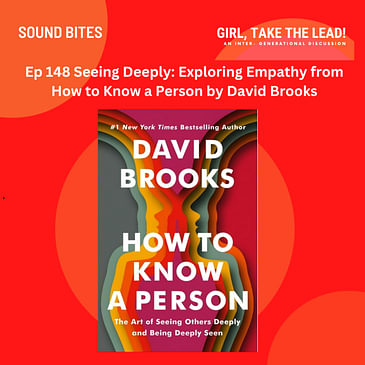This is a Sound Bite episode that builds on our previous episode with Bernadette Smith where we talked about Diversity, Equality and Inclusion efforts covering a variety of topics. One of them was about empathy and sincerity.
While we have covered this topic with Brené Brown’s book, Atlas of the Heart, I found another which you might find interesting: David Brooks’ book: How to know a Person – the Art of Seeing Others Deeply and Being Deeply Seen. And in today’s episode I’ll concentrate on his chapter called the Art of Empathy.
Here are the topics we covered:
- What gets in the way of being empathetic
- The 3 empathetic skills
- Practices to build empathetic talents
- Ways empaths see the world differently
As Mentioned:
David Brooks’ book:
How To Know A Person, The Art of Seeing Others Deeply and Being Deeply Seen
Ep. 15, Part 1 of 3 – Atlas of the Heart (Brené Brown) – How do the emotions, Empathy and Compassion, relate to leadership? Ep. 145, Part 1 of 2 – Navigating Relationships with Candor and Trust – Insights from Peter Yaholkovsky & Sue Staker Ep. 82, Book Discussion: Trust Yourself, Stop Overthinking and Channel Your Emotions for Success at Work by Melody Wilding Ep. 76, “Don’t Take It So Personally!” & Emotional Intelligence Ep. 80, Book Discussion: Emotional Agility by Susan David PhD with Help From The Velveteen Rabbit
More About David Brooks:
David Brooks is an op-ed columnist for the NY Times and a writer for the Atlantic and appears regularly on PBS NewsHour. He’s had several best sellers including The Second Mountain, The Road to Character, and the Social Animal.
How to Reach Yo Canny:
Our website:
You can send a message or voicemail there. We’d love to hear from you!
email:
yo@yocanny.com (Yo)
FB group: Girl, Take the Lead
https://www.facebook.com/groups/272025931481748/?ref=share
IG: yocanny (Yo)
LinkedIn:





